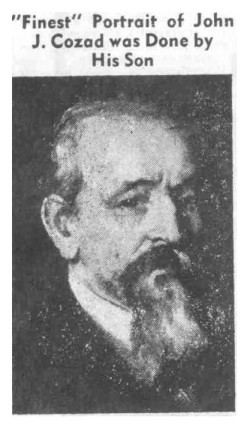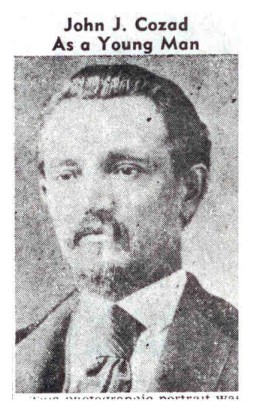“Reveal True Story of John J. Cozad”
From The Cozad Local, Tuesday, November 27, 1956.
Excerpts From Literary Digest At Time of Henri’s Death in 1929
HENRI, “TYPICALLY
AMERICAN.” A “BORN INSURGENT”
“The artist wants to paint the baby as he has seen it in the naturalness of its usual clothes. The mother wants it painted in its new dress and cap. There is nothing left of the baby but a four-inch circle of a fractional face, all the rest is new clothes.” There is a great deal in this that expresses the real Henri, and it may be a commentary on much of his own work, such as we show here; only he has had his way with his sitters, with no doting relative to interfere. We quote from his own book of art precepts, “The Art Spirit” (J. B. Lippencott Co.).
Everybody called him Henri; and it waspronounced in English, not French. Foremost among the painters of his generation, he was also a leader in all causes making for freedom. He once had a school, and even after it was closed, the school of Henri seemed to go on. “His Successes can not be limited to his own achievements in art,” says the New York Times, “They must include the impulse given to younger men who profited by his unfailing interest and confidence as surely as by the practical instruction they had from him. His death occurred on July 12, 1929, in New York City at the age of 64. He was typically American, continues The Times, “of French, Irish, and English ancestry, and in this international mingling of three rich strains of influence it is tempting to seek the source of his ardor for opening hospitable doors and for spending himself on causes that had for him no shred of personal advantage.” We extract some passages from the New York Herald Tribune’s account of him:
“He was a born insurgent, and he had not been a member of the National Academy more than a year before he was causing some long-settled dust to fly. In May, 1907, he withdrew two out of three of his pictures accepted by the Academy for its annual display, criticizing what he termed the narrow and unfair attitude of the Academy toward young artists.”
“Henri, already recognized not only as a strong painter but as a man of decided personal force and character, drew to his side six or seven of the notable young men, among whom was John Sloan, who later became the head of the Society of Independent Artists, with the principle, ‘No jury; no prizes.’ Henri remained in the Academy, and twelve years later he and the late George Bellows still were agitating for the discontinuance of the jury system.”
“His tenure of an instructorship at the New York School of Art ended in 1909, when he started a school of his own which drew many of his old pupils. His conception of a teacher’s duties then was in line with the most modern ideas.”
“There is an element of science in painting,’ he said, ‘and something of this can be taught. But it ought to be understood that the teacher is not imposing his own ideas on the student; he is simply helping the student to find his way to do the thing he himself wants to do.’”
“ ‘The artist is always ahead of the action of the crowd,’ he said on another occasion.”
“Henri became the foremost and best-known representative of the radical movement in America. His art is highly individual, and its chief characteristics are sincerity of purpose and simplicity of means. He had a flair for brilliant manipulation of pigments, and it was said of him that ‘he paints at the top of his voice.’”
“His brushwork is considered by critics as broad and vigorous, his color subdued yet luminous, and his tonal effects good. His landscapes are daring and original interpretations of nature, and a strong psychological insight marks his portraits.”
Much of Henri’s work is portraiture, but it is far afield from the conventional portraiture of the fashionable painter. What the individual’s name is scarcely matters; the picture is named for the character of the sitter it portrays. In a privately printed volume on “Robert Henri, His Life and Works” (1921), the editors, William Yarrow and Louis Bouche, present this summary”
“One finds in American painting no human documents more convincing than those portraits, notably, ‘The Young Woman in Black,’ ‘The Young Woman in White,’ and the studies of Spanish peasants. He seems to have developed less vigorously at this stage, and some of the canvases of his youth have a finality about then, which his later works lack. They mark a complete summary of that period of his artistic evolution, whereas his more recent paintings bear evidence of a mature intelligence and a continual and successful search for his own way of seeing nature. His work, then, like the work of all younger men, could more readily be cataloged as the product of a specific tendency while the pictures he is producing today could only be the work of Robert Henri. His growth has been a logical one. He is, first of all, tensely alive to the character of people, and perhaps no painter has ever portrayed that character more convincingly. Taken feature for feature, his portraits do not give the minute accuracy of statement demanded of the popular portrait painter, but they are far more alive than such stereotyped delineations. One receives from them the impression that they are the truth about the persons while Henri was observing them. Perhaps another day they would appear totally different, but the actual conformation, texture and color of their features would remain the same. One feels, despite Henri’s past experience, the entire absence of a set formula and an astonishing capacity to note his sitter’s appearance at a given moment. It may be the grin on a child’s face, the surly side glance of a Mexican, or the stolid stare of a Chinese girl, but it always convinces. The grin is slashed across the face, seemingly with carelessness, actually with remarkable accuracy; the surly face of the Mexican is heavy and sodden in treatment, and the Chinese girl is broadly and suavely painted, the resultant effect of which is a technical handling perfectly adapted to the character of his subject.” |


